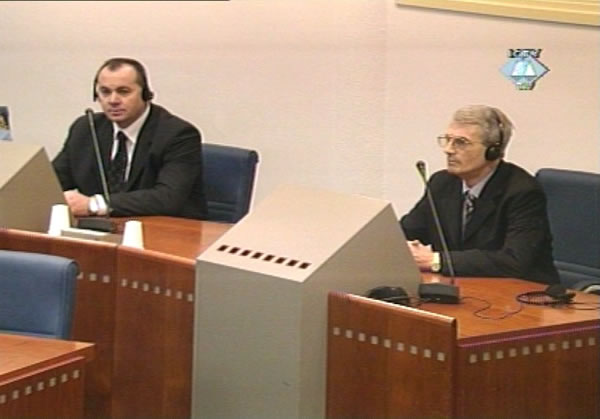Home
MUJAHEDIN FOUGHT WHERE THE FIGHTING WAS THE FIERCEST
Captain Mark Bower said that the bodies of the mujahedin killed in action could be found in places where the fighting between the BH Army and the HVO was the fiercest. – It seemed that the 7th Muslim Brigade was, together with the mujahedin, the "main fighting force" – The defense claims that the foreign fighters were not under the control of the BH Army 3rd Corps.
 Enver Hadzihasanovic i Amir Kubura in the courtroom
Enver Hadzihasanovic i Amir Kubura in the courtroom Through the testimonies of three British members of UNPROFOR at the trial for the crimes in Central Bosnia the prosecutor tried to prove that the mujahedin had been part of the BH Army and that therefore Enver Hadzihasanovic, the former commander of the 3rd Corps, and Amir Kubura, commander of the 7th Muslim Brigade had command responsibility for the crimes of these foreign fighters.
In the initial part of their case, the prosecution presented evidence about the murders of Croats and Serbs in Central Bosnia. According to vitims and eyewitnesses, they were committed by the mujahedin. The evidence pertained, among other events, to the murder of prisoners in Bikose, Miletici and in the Orasac area. At this stage, the prosecutor is adducing evidence about the position and role of the mujahedin in the military structure of the BH Army 3rd Corps, through testimony of international witnesses with military background.
All three witnesses – Major Kent-Payne and captains Cameron Kiggill and Mark Bower agreed in the opinion that the mujahedin spearheaded the attacks that the 3rd Corps launched in the summer of 1993 in the Lasva Valley. Captain Bower noted that the bodies of the dead mujahedin could be found in the areas where the fighting between the BH Army and the HVO was the heaviest, while some of them were captured there. "They were always in places where the fighting was the fiercest," said Bower, adding that the 7th Muslim Brigade and the mujahedin had been the "main fighting force used to reinforce the breakthrough actions." The witness concluded that "this happened too many times" and was "too well-coordinated" to be a "coincidence".
According to Bower, the "well-equipped" and "very confident" foreign fighters were an "element of the 7th Muslim Brigade" which was under the command of the accused Kubura, and the brigade itself was, it is alleged in the indictment, subordinate to the command of Hadzihasanovic's 3rd Corps, stationed in Zenica.
The defense has rejected these conclusions and submitted that there is evidence that the 3rd Corps did not control the mujahedin. In June 1993, when the crimes were committed, Hadzihasanovic sent a letter to his superior command asking for permission to take measures to bring the mujahedin under control. On 14 June he showed the letter to UNPROFOR, as confirmed by the reports compiled by the BritBat. The defense claims that the BH Army superior command then started taking measures to bring the foreign fighters under control or else to have them leave Central Bosnia. The implementation of such measures would mean that Hadzihasanovic fulfilled his obligations as a commander to prevent future crimes against the non-Muslim population.
UNPROFOR, however, was not convinced of the effectiveness of Hadzihasanovic's appeal. In its military information summary of 23 June 1993, BritBat notes that the 3rd Corps continues to use the "tactical worth" of the mujahedin and that Hadzihasanovic's letter "might be regarded as rhetoric" and an attempt to "deflect criticism away from the 3rd Corps.”
The problem of who exercised command over the mujahedin is one of the key issues at this trial. In the remaining two months of its case, the prosecutor will be presenting more evidence about the command structure of the BH Army in Central Bosnia. The defense is still preparing its case, during which it will have to persuade the judges that the accused took all reasonable measures to resolve the mujahedin problem.
Linked Reports
- Case : Hadzihasanovic & Kubura - "Central Bosnia"
- 2004-03-24 MUJAHEDIN "UNDER CONTROL"
- 2004-03-23 GENIE FROM THE LAMP
- 2004-03-18 A WORKDAY IN THE LIFE OF DETAINEES IN BUGOJNO
- 2004-04-07 MUJAHEDIN WERE NOT LIKED
- 2004-04-23 COMMANDER "FOX" HAD A WELL-STRUCTURED CORPS
- 2004-05-03 WRITTEN ORDERS ARE NOT ENOUGH
